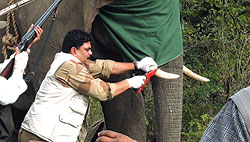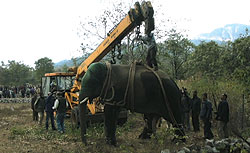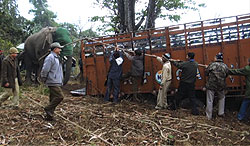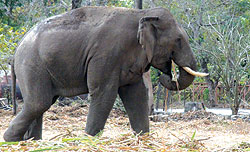Those of you who have travelled on the Haridwar-Rishikesh expressway would have witnessed that while entering Haridwar, river Ganga flows on your right hand side. After crossing Haridwar, the forest belt of Motichoor area of Rajaji National Park begins, beyond which there is Chilla Forest Range on the right and Ranipur, Beribada, Dhaulkhand and Mohund ranges on left. After this, you draw closer to another town called Raiwala and forest range. As the town ends, the same road bifurcates in two and beyond it starts Doiwala Forest Range and the forests extending and encircling Rishikesh. This entire stretch from Haridwar to Rishikesh is surrounded by forests of Rajaji National Park.
The presence of elephants is periodically observed in and around the townships of Haridwar and Rishikesh. An elephant is normally peaceful by nature and left to itself, tends to mind its own business. It’s only after repeated encounters with humans that it tends to lose its cool. Even then, most of its charges are mock ones, meant just to frighten. At times, a musth elephant—a periodic condition among bull elephants with a continued draining of bodily fluids from its temple glands—poses a big threat to humans. The phenomenon occurs once a year but as long as the musth period lasts, the elephant is unusually aggressive. This is a story of one such elephant.
|

|

|
|
Animals, if not threatened or cornered, are part of the lifecycle and survival of the planet. Mankind needs to understand that we have to give space to elephants and other species for harmonious coexistence. |
It was the morning of February 10, 2011, one of the coldest of the year. Sita Devi, a native of the area had concluded her usual household chores and went into the forest to collect fodder for her cattle. Unaware of the presence of a wild elephant, she busied herself in cutting grass. She stood up on hearing a peculiar noise but before she could react, she was blown away and smashed by the raging bull. This was the first victim of this notorious giant.
For the people living here, the terror had arrived without any warning. During the next 11 months, nothing could be more terrifying. Nobody ventured out alone on the road, particularly after sunset. For they didn’t know when—or from which unseen corner—the killer would strike. In a span of eleven months, nine people—including six women—died on this stretch of the road. Each of them killed by this elephant.
Often, the residents spotted the killer in a small herd of elephants which would appear regularly near the herbal garden on the outskirts of Rishikesh. The State Forest Department downplayed the first two killings. These were passed off as mere mishaps. After all, such incidents do happen in this particular sub-Himalayan belt. And it’s not uncommon for elephants to cross over from one stretch to another within a kissing distance of Rishikesh. It was only after the elephant had claimed its seventh victim on October 3—Awwal Singh—that the severity of the issue dawned on the authorities, stirring them into action.
 |
 |
| An elephant is normally peaceful by nature and left to itself, tends to mind its own business. At times, a musth elephant—a periodic condition among bull elephants with a continued draining of bodily fluids from its temple glands—poses a big threat to humans |
Initial efforts to catch the elephant proved futile. Often, the animal would disappear into the forest and everyone would heave a sigh of relief. But the peace was short-lived. Like the proverbial ghost from darkness, it would reappear after a few days and resume its rampage. When all efforts to capture the killer elephant failed, the Uttarakhand forest department turned to another State for help. An expert elephant catcher from Assam, Dipen Kalita, veteran of numerous encounters with the rogue elephants of northeast, also joined the operations along with a trained mahaut, Rawa, and reached Rishikesh in the first fortnight of November. It was at this time that Digvijay Singh Khati, CCF Uttarakhand, called up my office for help and support and I immediately dispatched my team of Kishan Dev, Shivender and Abhinav to Rishikesh to provide with whatever logistic support was required. My business commitments as Chairman of Raheja Developers did not permit me to be able to camp personally in the area, in view of a prolonged and time consuming operation which lay ahead.
Three trained elephants were summoned from the Corbett National Park nearby. Apart from this, senior officers of Rajaji National Park along with some two dozen forest guards camped in the area for over a month making it one of the biggest operations of its kind. It soon transpired, however, that the elephant was much smarter than the trained force set up for its capture. In no time, it afflicted serious wounds on Pawanpari and Gomti—two of the three trained elephants brought from Corbett Park for the operation. On November 22, a small success came though, the team managed to tranquilise the elephant but by then, darkness had engulfed the area and it could not be pulled out of the dense thicket.
By the end of November, the Chief Wildlife Warden of Uttarakhand and Chief Conservator of Forest, Digvijay Singh Khati were supervising the operation on a day-to-day basis. Experts from the Wildlife Institute of India, Wildlife Trust of India as well as the man who would put the dart into elephant’s body, Dr Parag Nigam, a senior scientist from the Wildlife Institute of India also camped in the area for several weeks. Several patrol parties were formed to search for the elusive tusker. At times, the team would manage to get close to the elephant but would be outsmarted by it at the last minute.
Meanwhile, the killer elephant of Rishikesh kept on playing hide-and-seek with an army of 50-plus forest guards, senior forest officials, doctors, mahouts and others.
It was exasperating; the authorities even invited a local hunter, Sanjay Singh, from Moradabad. For about a week, Sanjay and his team-members scouted the region, and returned empty handed. While this particular elephant had eight victims to its credit, a large number of people managed to escape with their life in the nick of time. Camera traps were put up at several places to track down the elephant. But to no avail. On the other hand, in an effort to keep people out of the forest—where there were more chances of a conflict with the rogue elephant—experts and volunteers from Wildlife Trust of India held several interactive sessions with the residents as to how they can protect themselves from the animal. Success, though much delayed, arrived suddenly and swiftly on January 4, 2012. That morning, the tusker came ambling to the herbal garden and even charged at the forest staff. But this time, having acquired a fair knowledge of tusker’s behavior, the forest department was prepared. Dr Parag lost no time in putting the dart into the tusker, promptly sedating it. The first thing the officials did was to cut off the pointed ends of its tusks—necessary to reduce its aggression towards humans. Catching an elephant is one thing but putting it into a truck is an elephantine task. It took more than an hour for authorities to carry it off.
An elephant in a truck is not a usual sight, even on Indian roads and as the vehicle passed through the busy streets of Rishikesh, people trooped out to have a last look at the killer which had kept them on tenterhooks for 11 months. The elephant—it has now been named Narendra—was taken 30 km inside the Chilla range of Rajaji National Park and set free. Forest authorities hope the tusker will start life afresh in his new home. The panic, however, remains anew in their thoughts.
For centuries, the forest stretch connecting Rajaji Park with Corbett Tiger Reserve had been a natural corridor for elephants but no more. It is now fragmented at several places. Human advancement has radically affected the corridor. The fragmentation of corridor and encroachment of natural habitat are the prime reasons for man-animal conflicts. In the present age the mindless developmental activities in and around the Rajaji National Park, such as the construction of the Ganga canal, Raiwala ammunition dump, mindless development of Ashrams, farms, residences and putting up of industries around Rishikesh and Haridwar and also carving up of colonies has led to the fragmentation of the elephant corridor which a decade ago existed from the foothills of Shivalik to Tarai to the sub-Himalayan belt reaching up to Bihar and Nepal where the elephant had a free movement. This has also adversely affected the gene pool of the Asiatic elephant.
|